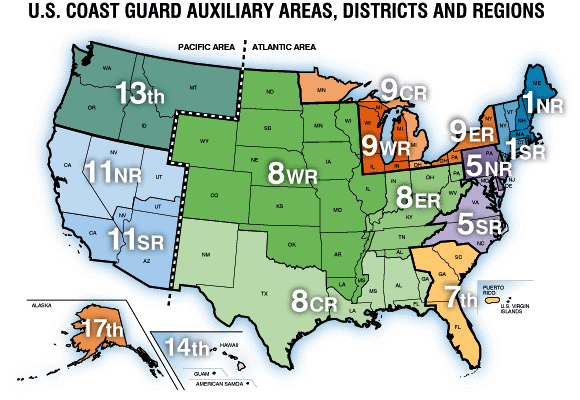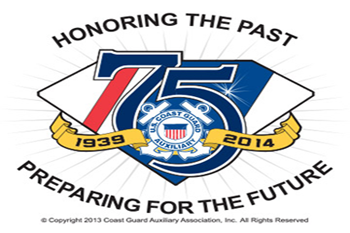Return to A-Directorate's Home Page.
U.S. Coast Guard Auxiliary: A Proud Tradition, A Worthy Mission
For over 70 years, tens-of-thousands of men and women of the Coast Guard Auxiliary have spent millions of volunteer hours helping the Coast Guard carry out its mission. They have saved countless lives through their work, on and off the water. Auxiliarists are probably best known for educating the public through their boating safety classes and vessel safety checks. Yet, they do much more. The Coast Guard Authorization Act of 1996 allows the Auxiliary to assist the Coast Guard in performance of any Coast Guard function, duty, role, mission or operation authorized by law and authorized by the Commandant.
When the Coast Guard "Reserve" was authorized by act of Congress on June 23, 1939, the Coast Guard was given a legislative mandate to use civilian volunteers to promote safety on and over the high seas and the nation's navigable waters. The Coast Guard Reserve was then a non-military service comprised of unpaid, volunteer U.S. citizens who owned motorboats or yachts.
Two years later, on February 19, Congress amended the 1939 act with passage of the Auxiliary and Reserve Act of 1941. Passage of this act designated the Reserve as a military branch of the active service, while the civilian volunteers, formerly referred to as the Coast Guard Reserve, became the Auxiliary. So, February 19 is formally recognized as the birth of the Coast Guard Reserve while June 23 is recognized as birthday of the Coast Guard Auxiliary.
When America entered World War II, 50,000 Auxiliary members joined the war effort. Some auxiliarists served weeks at a time with the Temporary Reserve. They guarded waterfronts, carried out coastal picket patrols, rescued survivors from scuttled ships and did anything else they were asked to do. Many of their private vessels were placed in service.
After the war, auxiliarists resumed their recreational boating safety duties. The Auxiliary's four cornerstones - Vessel Examination, Education, Operations and Fellowship - were established and remain the Auxiliary's pillars in the 1990s.
The Vessel Examination program evolved into the well known Vessel Safety Check (VSC), a free examination available to any recreational boater. VSCs help boaters ensure their craft complies with Federal regulations regarding safety equipment requirements.
As for education, the Auxiliary teaches boating safety to recreational boaters of all ages. The Auxiliary offers Boating Skills and Seamanship (geared toward power boaters) and sailing courses (for sail-boaters) as well as basic and advanced navigation courses.
The Auxiliary operates safety and regatta patrols and is an integral part of the Coast Guard Search and Rescue team. Auxiliarists also stand communication watches, assist during mobilization exercises, perform harbor and pollution patrols, provide platforms for unarmed boarding parties and recruit new people for the Service.
Today, as in 1939, auxiliarists are civilian volunteers who are authorized to wear a uniform similar to the Coast Guard Officer's uniform. Distinctive emblems, buttons, insignias, and ribbons are employed to identify the wearer as a member of the Auxiliary. One such insignia is the letter "A" on the shoulder boards of an auxiliarist. Despite their silver shoulder boards (versus gold for Coast Guard officers), auxiliarists hold no rank. The shoulder boards symbolize the office and level to which an individual auxiliarist has been either appointed or elected.
The Auxiliary has members in all 50 states, Puerto Rico, the Virgin Islands, American Samoa, and Guam. Membership is open to men and women, 17 years or older, U.S. citizens of all states and territories, civilians or active duty or former members of any of the uniformed services and their Reserve components, including the Coast Guard. Facility (radio station, boat or aircraft) ownership is desirable but not mandatory.
or active duty or former members of any of the uniformed services and their Reserve components, including the Coast Guard. Facility (radio station, boat or aircraft) ownership is desirable but not mandatory.
Although under the authority of the Commandant of the U.S. Coast Guard, the Auxiliary is internally autonomous, operating on four organizational levels: Flotilla, Division, District Regions and National.
Flotilla - The flotilla is the basic organizational unit of the Auxiliary and is comprised of at least 15 qualified members who carry out Auxiliary program activities. Every auxiliarist is a member of a local flotilla. Each flotilla is headed by a Flotilla Commander (FC).
Division - For maximum administrative effectiveness in carrying out Auxiliary programs, flotillas in the same general geographic area are grouped into divisions. The division provides administrative, training and supervisory support to flotillas and promotes district policy. Each division is headed by a Division Captain (DCP), and Division Vice Captain (VCP) and usually consists of five or more flotillas.
District/Region - Flotillas and divisions are organized in districts comparable to the Coast Guard Districts and must be assigned the same district number. Some districts are further divided into regions. The district/region provides administrative and supervisory support to divisions, promotes policies of both the district commander and national Auxiliary committee. All districts and regions are governed by a District Commodore (DCO), District Vice Commodore (VCO), and District Rear Commodores (RCOs), under the guidance of the Coast Guard District Commander. At this level, Coast Guard officers are assigned to oversee and promote the Auxiliary programs as district Directors of Auxiliary.
National - The Auxiliary has national officers who are responsible, along with the Commandant, for the administration and policy-making for the entire Auxiliary. These officers comprise the National Executive Committee (NEXCOM) that is composed of the Chief Director of Auxiliary (an Active Duty officer), National Commodore and the National Vice Commodores.
NEXCOM and the National Staff make up the Auxiliary Headquarters organization. The Chief Director is a senior Coast Guard officer and directs the administration of the Auxiliary on policies established by the Commandant. The overall supervision of the Coast Guard Auxiliary is under the Assistant Commandant for Operations (G-O), who reports directly to the Commandant. Interested people can learn more about the Coast Guard Auxiliary in the Auxiliary Manual (COMDTINST M16790.1D) or by contacting the sources listed at right.
Auxiliarists are dedicated civilians who believe strongly in the Coast Guard and its missions. A hearty thank you is the only pay an auxiliarist expects. Personally, they receive tremendous satisfaction for a job well done. They have proven valiant throughout the years and take the oath of membership seriously. They contribute immeasurably to our Team Coast Guard efforts.

CG Auxiliary Missions:
- Vessel Safety Checks
- Commercial Fishing Vessel Examinations
- Public Education
- Recreational Boating Safety
- Marine Environmental Protection
- Search & Rescue
- Air Operations
- Aids to Navigation/Chart Updating
- State Liaison Programs
- Recruiting for the Coast Guard and Academy
- Public Affairs
- Bridge Administration
- Merchant Mariner Exam Administration
- Training
- Work-Life Program Administration
An Average Day in the USCG Auxiliary:
- Educated 929 People on Recreational Boating Safety & Marine Environmental Protection
- Completed 7 Regatta Patrols
- Completed 91 Safety Patrols
- Accomplished 19 SAR Assists
- Saved $729,000 Worth of Property
- Assisted 56 People in Trouble on Water
- Completed 15 Recruit Support Missions
- Performed 615 Vessel Safety Checks
- Participated in 120 USCG Operational Support Missions
- Participated in 42 USCG Administration Support Missions
- Completed 122 Public Affairs Missions
- One or two recreational boaters, whose death was certain - somewhere on the waters of the U.S. - had his or her life saved by a Coast Guard Auxiliarist.
